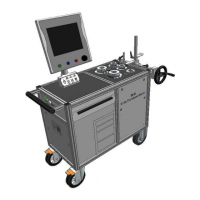Appendix B – Processes and Statistics BLM 3750 User Guide
72 (78) 9836 3078 01 Edition 2.0
The higher the value, the less the dispersion of the values and the better the Cp index.
But the Cp value is only a measurement of dispersion; in other words, the amplitude of distribution of the
values around the mean value, not their centering.
In the specific case of a power tool, the Cp index may be of acceptable size (greater than 1), meaning that
there is limited dispersion around the mean value, but this mean value could differ considerably from the
expected value.
This would mean that the power tool is of good quality as the torque values are all around the same
absolute tolerance value, but that it has not been calibrated correctly and thus needs to be re-calibrated.
Cpk index
While the Cp is simply a measurement of dispersion, the Cpk index is a measurement of both the
dispersion and the centering: i.e., its calculation formula takes into account both the amplitude of the
distribution and its location as compared to the mean point. The formula is:
⋅
−
⋅
−
=
σσ
3
,
3
min
min
max
LX
XL
Cpk
By selecting the lesser of these two values, we discover just how reliable our process is with regard to the
least desirable part of the distribution (that closest to the specifications limits).
• The highest Cpk value is the most desirable: A Cpk value greater than 1 means that the 6σ
(±3σ) amplitude of the values measured falls completely within the limits of the specifications.
• A Cpk value of 1 means that one edge of the 6σ amplitude falls within the specifications limit.
• A Cpk value between 0 and 1 means that part of the 6σ amplitude falls outside of the set limits.
• A negative Cpk value indicates that the mean of the values is not within the specifications
limits.
The following diagrams show the distribution patterns for the four different types of Cpk value.

